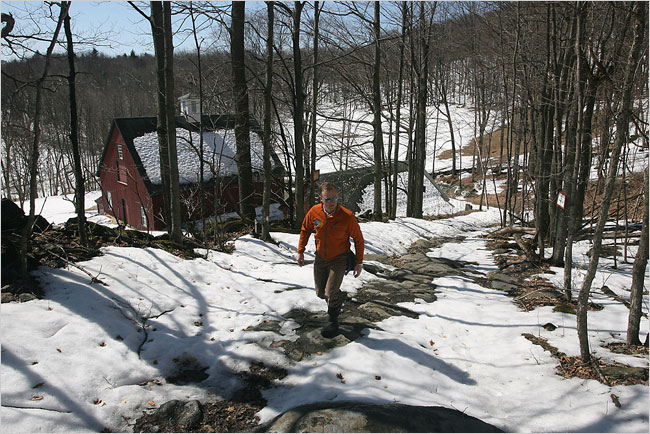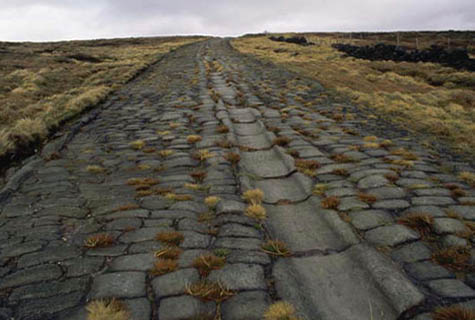Ancient Roads
 [Image: Walking an "ancient road" in Vermont; photo by Joseph Sywenkyj for The New York Times].
[Image: Walking an "ancient road" in Vermont; photo by Joseph Sywenkyj for The New York Times].Half-forgotten slashes of land, cutting through, around, and over the hills of Vermont, might actually be "ancient roads," dating back to colonial times – and a 2006 state law has given the residents of nearby towns a strong incentive for uncovering these buried throughways.
According to The New York Times, "citizen volunteers are poring over record books with a common, increasingly urgent purpose: finding evidence of every road ever legally created in their towns, including many that are now impassable and all but unobservable." These "elusive roads" – many of them "now all but unrecognizable as byways" – are lost routes, connecting equally erased destinations.
In almost all cases, they've barely even left terrestrial traces; in fact, as we'll see, their presence is almost entirely textual.
If these roads can be re-discovered, however, then they can be added to official town lands. Accordingly:
- Some towns, content to abandon the overgrown roads that crisscross their valleys and hills, are forgoing the project. But many more have recruited teams to comb through old documents, make lists of whatever roads they find evidence of, plot them on maps and set out to locate them.
Indeed, like something out of the poetry of Paul Metcalf, or even William Carlos Williams, the descriptions found in these old documents are narrative, impressionistic, and vague. They "might be, 'Starting at Abel Turner’s front door and going to so-and-so’s sawmill,' said Aaron Worthley, a member of the ancient roads committee in Huntington, southeast of Burlington. 'But the house might have burned down 100 years ago. And even if not, is the front door still where it was in 1815? These are the kinds of questions we’re dealing with.'"
 [Image: A hand-written inventory of Vermont's ancient routes; photo by Joseph Sywenkyj for The New York Times].
[Image: A hand-written inventory of Vermont's ancient routes; photo by Joseph Sywenkyj for The New York Times].While making sense of cryptic references to lost byways is fascinating in and of itself, these acts of perambulatory interpretation are part of a much larger, fairly mundane attempt to end "fights between towns and landowners whose property abuts or even intersects ancient roads."
- In the most infamous legal battle, the town of Chittenden blocked a couple from adding on to their house, saying the addition would encroach on an ancient road laid out in 1793. Town officials forced a showdown when they arrived on the property with chain saws one day in 2004, intending to cut down trees and bushes on the road until the police intervened.
Think of it as landscape hermeneutics: hunting down traces of a disappeared landscape.
So what would happen, then, if you discovered that an ancient road actually passes through your house – that your living room is a former throughway, and old paths knot and twirl off to every side, one leading right through the guest bedroom? And then another road pops up, and another – and you realize that you live on the intersecting scars of a lost built environment, some old village that disappeared or was destroyed in some H.P. Lovecraft-like enigmatic disaster.
I'm also curious, though, to see what might happen if such a law was passed in a city like London. In an old but interesting review of London: City of Disappearances, a book edited by Iain Sinclair, we're told that London "is a city of the forgotten." It is where anyone "can still disappear without trace." Indeed, London is a city "built upon lost things"; it "towers above forgotten underground rivers and discarded tunnels. It is built upon old graveyards and burial pits."
More to the point here, entire streets have disappeared: "Catherine Street, Jewin Street, Golden Place are just three of the vanished thoroughfares named in a litany of sorrowful mysteries," our reviewer points out. "Other streets have been curtailed. Swallow Street has been swallowed by burgeoning London. Grub Street has been renamed Milton Street."
So what if someone who liked "getting out and looking for hints of ancient roads" were to set about such a task elsewhere? I'm reminded here of China Miéville's short story "Reports of Certain Events in London" – a perennial reference on BLDGBLOG – in which "unstable" streets appear and disappear throughout the city. One night they're there, the next night they're not.
 [Image: An old Roman road in Britain; photo via Historic UK].
[Image: An old Roman road in Britain; photo via Historic UK].But what to make of entire unstable geographies that flash in and out of county land registers, with distant echoes appearing in the hand-written captions of family albums and in old, yellowing letters between loved ones? Could you re-trace ancient roads based on such sources? What if the county's land archivist was Borges?
Perhaps it'd be a bit like reconstructing all of postwar Berlin, or Dresden, or Hiroshima, based only on geographical descriptions found in the journals of former residents.
How piece together a whole city from a position of extreme textual remove?
I suppose the answer to that question might be found in Vermont over the next few months, with people jogging up and down hillsides, and in and out of archives, tracking down the specters of an older terrain – territorial marks of a vanished world on top of which they've been living all along.
(Of interest, earlier on BLDGBLOG: Ancient Lights and Z).





Comments are moderated.
If it's not spam, it will appear here shortly!
I don't know about London, but you can definitely spend lots of time searching out disappeared roads and "paper streets" in San Francisco. Some of them are still mapped by the city; others have lost their legal status but can be found from old maps.
I enjoyed seeing the ancient roman road from New York to Philadelphia. It was very impressive and I was certain I felt history sneaking up my feet.
"Landscape hermeneutics" is a great way to describe this. I haven't had a good phrase to describe it until now, but I called it pattern recognition in the built environment when I was feeling particularly verbose.
I've done a lot of landscape hermeneutics with former rail lines. I'm working on photographing every town in North Dakota, and most of these towns were built on a rail line. Many of those lines are now long-gone, so there's often a ridge running through the town where the railroad used to be. Some of the tiniest spots (like Petrel) that still manage to get on the map can only be identified by a swath of cleared land where a railroad siding and depot might have been.
Only tangentially related, check out the video of 'cities at night' at spaceandculture.org
Astronauts using digital cameras to take sharper images of cities around. Different lighting technologies producing different colors, etc.
Particularly intersting though, towards the end of the video is DC. The sharp diamond of the district is clearly visible.
Political jurisdictions defining by light seen from space...
"Landscape hermeneutics" in Pittsburgh is the subject of my whole blog, which you can find at
aphilotus.blogspot.com
My cohort and I spend quite a few evenings wandering the city looking for strange old thoroughfares, and then doing the research to find why they are still sort of here. It's fun, and definitely weird!
I'd like that job.
Between historic maps and texts, and modern maps and satellite photography (which does reveal a bit), I can sometimes find these ancient roadways.
Though, where I live, the road layout is pretty square (laid out in the 1840s), and developed a lot later than colonial era locations.
Former railway lines are usually easy finds, since they mostly have been abandoned beginning in the 1950s.
That story sends a message too about permanence. The earth reclaims its territory very quickly! As a Vermonter living in a rural area, I'll keep you posted if I hear of any intersections that turn up under peoples' homes!
This reminds me of something I wrote. And also the follow-ups.
Basically: It's some of the history of US 12 through the Lochsa river drainage in Idaho.
For the last two years I've been on a National Trust committee working on heritage listing for Coxs Road, the first road across the Blue Mountains west of Sydney that opened up Australia to european settlement. Its bicentenary is in 2015.
Numerous pieces of it survive intact and it does indeed sometimes disappear under houses. I've also been working on an overlay of it for Google Earth and even some virtual sections done using SketchUp, which all links back a few posts to the post about mapping fictional worlds. Its entire construction is detailed in the diaries and reports of its builders so that it can still be tracked through farmland where there is no visible trace of it.
It also relates to Australian indigenous mapping via ancestor stories and songlines to produce virtual highways that can easily be followed but have very little obvious physical evidence of their existence.
Geoff, you know that green hill of trees off to the southwest when you stand at Cole and Frederick? That's Sutro Forest, and there are still trails up there and a cave used by Ishi, one of the last native Californians to live most of his life outside of the Europeanized world. Ishi spent his last few years living up at UCSF, hunting and eating plants from those woods, and talking to the pioneering anthropologists Alfred and Theodora Kroeber about Yahi culture. When I pass those UCSF buildings on Parnassus, I often think of Ishi up there, stealing out of those sterile hallways and rooms to hunt in the old way. I've walked on his trails.
Hi everyone,
I'm a student at Cornell University and I'm working on a paper about the Romance of Ruins for my Nature and Culture course. Since reading through this blog I've become quite curious as to why we are so fascinated by ruins and what makes a person perceive a set of ruins as more interesting than others. The topic is really exciting and has been a lot of fun researching, but I'm hoping that someone out there might have some more recommendations for sources to tap for more info.
Thanks for the help!
http://www.icknieldwaypath.co.uk/
Another one for your perusal
For a lot of people this is obviously romantic fun. If you own a piece of land, however, it's a nightmare. And if you were thinking of settling in Vermont, you probably won't now.
I recently rode the train from Oakland, CA down to Morro Bay. The rail line roughly follows the old Spanish "El Camino Real," the rode that linked all the missions in colonial times. It's interesting to see it from the train - sometimes a busy freeway, sometimes a quiet two-lane road, sometimes a disused dirt track running behind a house. There are abandoned gas stations, obvious old sites of settlement, and brand new liquor stores - really a link to the distant past.
James...your blog is closed to all but invited visitors. Why not just make it an open blog?
aphilotus.blogspot.com
looks like a very cool blog.
Post a Comment